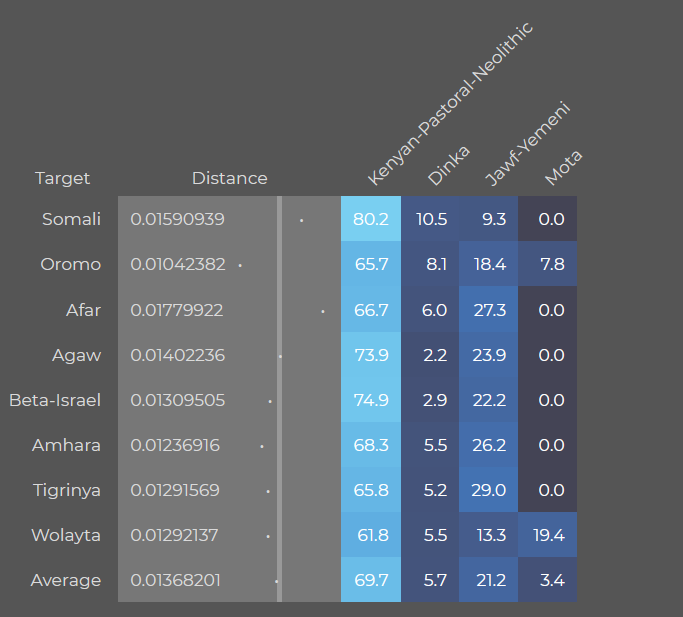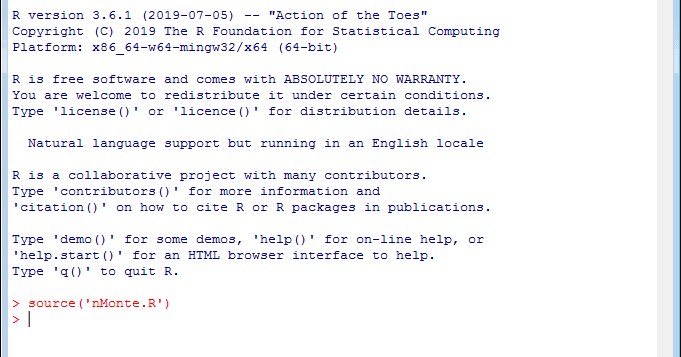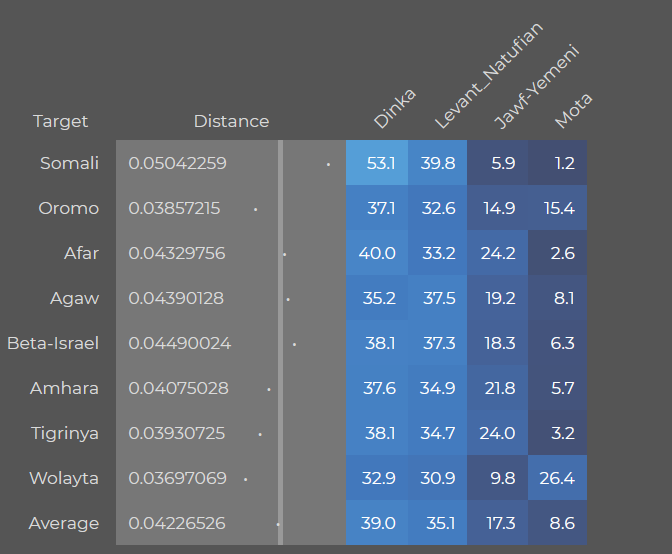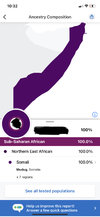Feel like we should have a thread for sharing genetic models for Somalis and other Horners like other Cushites, Ethiosemites, Omotics and even Horner Nilotes and the minority Bantus in Koonfur.
I'll start by sharing this model:

Made it using PCA positions from the Global25 PCA from Eurogenes. A very pristine, 25 dimensional PCA (Principal Component Analysis / genetic cluster) based on hundreds of thousands of autosomal SNPs that has proven very informative for creating ancestry composition models for populations, provided you know what you're doing and understand the limitations. The results often come very close to formal stat data (like qpAdm) from peer-reviewed papers and the author of Eurogenes, David Wesolowski, has been running all these genomics tools for like a decade and consistently rubs shoulders with academics from institutions like HarvardMed who comment on the results posted on his blog from time to time so the saaxiib knows what he's doing:

 eurogenes.blogspot.com
eurogenes.blogspot.com
@Apollo The model I ran is basically close to what I think we'll see once we have "pure" early Cushite samples that lack Mota-related (Horn Hunter-Gatherer) ancestry. These Kenyan-Pastoral-Neolithic samples have a lot of Horn to Southeast African HG ancestry with its substantial San/Southern HG type admixture so they eat up the "Mota" scores of all Horners except for the Oromos and Wolaytas who have the most:

Hmm, but I'm still surprised by these lower numbers. I've been out of the modeling game for a while since I lacked a laptop for months and had personal issues (long story) but I'll see if I can't get higher numbers. Anyway, point is I think the general gist of the Horn Cushites and Ethiosemites' genetic story will turn out:
I've seen people theorize that maybe it's something real and there was a real early Nilotic related migration into the Horn probably between 0 CE and 3000 BCE given that Horners lack West-African ancestry but I doubt it. We'll see, I guess.
Anyway, guys, feel free to share your own models when you get the hang of it and models from loads of other tools like formal stats (qpAdm) or even Gedmatch and old admix calculators if you feel they're relevant. Go ham!
I'll start by sharing this model:

Made it using PCA positions from the Global25 PCA from Eurogenes. A very pristine, 25 dimensional PCA (Principal Component Analysis / genetic cluster) based on hundreds of thousands of autosomal SNPs that has proven very informative for creating ancestry composition models for populations, provided you know what you're doing and understand the limitations. The results often come very close to formal stat data (like qpAdm) from peer-reviewed papers and the author of Eurogenes, David Wesolowski, has been running all these genomics tools for like a decade and consistently rubs shoulders with academics from institutions like HarvardMed who comment on the results posted on his blog from time to time so the saaxiib knows what he's doing:

Getting the most out of the Global25
The first thing you need to know about the Global25 is that I update the relevant datasheets regularly, usually every few weeks, but they'r...
@Apollo The model I ran is basically close to what I think we'll see once we have "pure" early Cushite samples that lack Mota-related (Horn Hunter-Gatherer) ancestry. These Kenyan-Pastoral-Neolithic samples have a lot of Horn to Southeast African HG ancestry with its substantial San/Southern HG type admixture so they eat up the "Mota" scores of all Horners except for the Oromos and Wolaytas who have the most:

Hmm, but I'm still surprised by these lower numbers. I've been out of the modeling game for a while since I lacked a laptop for months and had personal issues (long story) but I'll see if I can't get higher numbers. Anyway, point is I think the general gist of the Horn Cushites and Ethiosemites' genetic story will turn out:
- Neolithic Cushites enter the Horn around 3000 BCE bringing with them cattle, goat, sheep, donkey and dog domestication, grain-collecting, pottery, bows & arrows, stelae, dolmens, burial mounds, rock-carvings and rock-paintings while being mix between proto-Nilotes and Neolithic Egyptians. More the latter than the former probably like the "Ethio-Somali" component at a 60:40 to 70:30 ratio. This is the bulk of all Cushites and Ethiosemites' ancestry (~60-70%+).
- Varying degrees of admixing with local Horn HGs similar to the Mota Hunter-Gatherer from Southwest Ethiopia occur. Anything from 1-20% ancestry depending on the Cushitic and Ethiosemitic group.
- Ancient Yemenis hit the scene around 1000 BCE and after bringing with them metallurgy, writing, monumental architecture, camel domestication, asiatic admixture into other local livestock, Proto-Ethiosemitic (PES) and about 10-30% of the ancestry in most Cushites and Ethiosemites overtime as Horners have internal migrations and spread this admixture across the region from northern Eritrea and Ethiopia.
You don't have permission to view the spoiler content.
Log in or register now.
I've seen people theorize that maybe it's something real and there was a real early Nilotic related migration into the Horn probably between 0 CE and 3000 BCE given that Horners lack West-African ancestry but I doubt it. We'll see, I guess.
Anyway, guys, feel free to share your own models when you get the hang of it and models from loads of other tools like formal stats (qpAdm) or even Gedmatch and old admix calculators if you feel they're relevant. Go ham!




